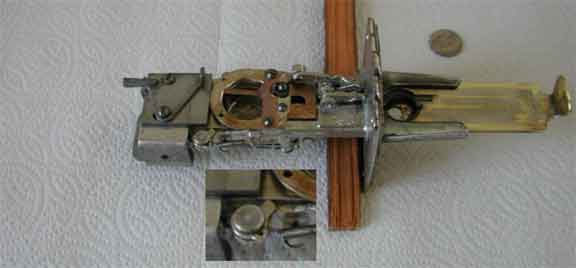
Coin-Op Mechanisms:
These mechanisms are displayed and explained. Using browswer technology, roll over buttons are used to provide a sequence of pictures, showing the mechanism in action. A detailed explanation is also included, explaining the objectives of the mechanism's operation.
(Please let me know if the process does not work on your machine or if you have an helpful suggestions on how I might improve this section. Contact the author below.)
- baseball base running (Genco Official Baseball, 1934)
-
The base runners are simulated by the movement of balls through channels on the playfield. Base hits, doubles, triples, and home runs are correctly positioned and counted
- bingo screen (Bally Bingos, 1950s)
-
The bingo magic screen rotates color segments in front of a bingo card. The player is enticed to play more money in the hopes of being able to move the screen to a better position, thereby winning more credits.
- coin counter (generic)
-
The coin counter is generic and is found in many games, from early 1940s to 1960s. It counts the number of games that were played or the number of coins deposited.
- coin slide (generic)
-
The coin slide checks the coin's shape and thickness and prevents playing a game without the correct coin. It also prevents the player from partially inserting the slide and jiggling it to obtain free games.
- coin rejector (Jennings Sportsman, 1935)
-
The coin rejector sorts magnetic coins into the coin feed, non-magnetic coins into the coin box. This enables the establishement to track real money and tokens and give the impression of not allowing gambling.
- coin payout (Jennings Sportsman, 1935)
-
The coin payout mechanism pays out from 4 to 16 coins, powered by a player pulling a lever and controlled by electricity.
- coin payout (Mills Railroad, 1936)
-
The Mills payout mechanism is motor driven and slices coins until an electrical contact is broken, indicating sufficient coins are paid.
- Coon Hunt gear box (Seeburg, 1955)
-
The Mills payout mechanism is motor driven and slices coins until an electrical contact is broken, indicating sufficient coins are paid.
- credit unit (Bally, 1968)
-
The credit unit counts up and down by one, keeping track of won and played games. This is a three digit unit out of a bingo pinball machine
- early score unit (Rotortable, 1937?)
-
This is a score unit from Confucius Say (Rotor Table, 1937) It shows how one wheel will score the 1,000s and upon reaching 19,000, the wheel resets and a smaller wheel is incremented. The smaller wheel keeps count by 20,000 from zero to 80,000
- photo booth camera (PhotoMe, 1960s to current)
-
The Mills payout mechanism is motor driven and slices coins until an electrical contact is broken, indicating sufficient coins are paid.
